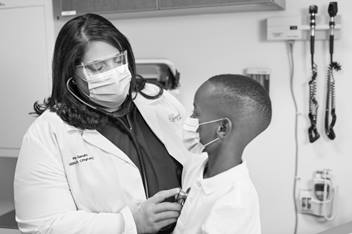Using a Transportation Model to Expand School-Based Health

The core missions of school-based health are delivering health care services to children who aren’t receiving them, in the place where children spend much of their time: school. Students can walk down the hall in some cases, get a checkup, and are back in class before the end of the period. Healthy students are better learners.
But only a small fraction of schools have a school-based health center – even in central Ohio, where Nationwide Children’s Hospital runs what is perhaps the most robust school-based health initiative in the United States.
What about students who don’t have a care center at their school?
Nationwide Children’s and CareSource, the Dayton-based nonprofit managed care organization, have come together to pilot a transportation model that gives more students greater access to the services that school-based health can provide.
“So many schools like the idea of a school-based health center, but it takes resources and coordination to make one successful – including making sure that as many students as possible benefit,” says Kimberly Radominski, MS, RN, PNP, PMHS, school-based health administrator for CareSource. “We hope this model shows a way that can happen.”
Nationwide Children’s runs 17 school-based health centers in central Ohio; 67% of the students covered by Medicaid who had a well visit at the centers in 2023 had not had one in at least 18 months, and in many cases, several years. The hospital’s school health services program has proven to be an important way that thousands of children receive the care they need.
The hospital also has two mobile care centers for students, a “roving” dental clinic and other mobile services, but most of the medical care in the school-based program is delivered in stationary centers, says Mary Kay Irwin, EdD, senior director of Nationwide Children’s school-based initiative. There are important reasons for this, including that a school-health center becomes an accepted part of a school community when it is actually inside the school building.
But that does limit the reach of each individual school-based center. Nationwide Children’s and CareSource asked, how could that reach be expanded?
CareSource began its own school-based initiative in 2019, said Donna Gabbard, MSN, RN, MHA, CCM, director of Women’s and Children’s Health at CareSource. Among other roles, CareSource is an Ohio Medicaid managed care plan, covering 250,000 children in the state.
“We realized we had significant opportunity to outreach and interact with school partners to make a difference in the lives of children,” Gabbard said.
Much of CareSource’s school-based focus involves addressing social determinants of health across 20 school districts, particularly in Montgomery, Hamilton, Logan, Champaign, Lucas and Franklin counties. It has provided coats to students, helped bring mobile dental and vision services to schools, and traveled across Ohio to educate about the challenges that children covered by Medicaid may face. CareSource has also partnered with Shoes 4 the Shoeless, which serves 13 counties in southwest Ohio, to provide new shoes and socks to students in need.
Dr. Irwin, leader of the Nationwide Children’s school-based effort, began regular conversations with the CareSource team about obstacles – and ways to overcome those obstacles – that school-based health programs regularly face. Transportation concerns were at the top of the list.
Nationwide Children’s and CareSource decided to work together to create a solution. CareSource would provide funding for buses to transport students of schools without school-based health centers to the centers in other schools. Nationwide Children’s would lead the operations.
The proof-of-concept work began in April 2023. Over the course of six weeks, 100 students from 15 Columbus City Schools were transported to two school-based health centers, completing 85 appointments. That experience led the project in Columbus to expand in the fall of 2023.

Nationwide Children’s brought the initiative to Reynoldsburg City Schools as well, and Dayton Children’s Hospital joined the initiative in the fall of 2023, transporting students to school-based health centers in Xenia Community Schools. In all, hundreds of health care visits were completed that would not have happened otherwise.
“We definitely had lessons to learn about how this can work, from making sure students didn’t miss school lunches to clearly identifying point people (and back-up point people) at every location,” said Dr. Irwin. “But we’re excited about what we have been able to accomplish with CareSource, and we hope we’ll be able to do more.”
The partnership did exactly what CareSource and Nationwide Children’s has hoped, said Radominski – develop an evidence-based model that other health care organizations and school districts can replicate to expand school-based care access.
“We have a really trusting relationship with the team at Nationwide Children’s, and together we’ve been able to make a difference in student health,” said Gabbard.
“So many schools like the idea of a school-based health center, but it takes resources and coordination to make one successful – including making sure that as many students as possible benefit. We hope this model shows a way that can happen.”



